Kiev Metro
| Kiev Metro Київський метрополітен Kyivs'kyi metropoliten |
|
|---|---|
 |
|
| Info | |
| Owner | Kiev City Council |
| Locale | Kiev |
| Transit type | Rapid transit |
| Number of lines | 3 |
| Number of stations | 46 |
| Daily ridership | 1.6 million (approximate) |
| Operation | |
| Began operation | 1960-06-11 |
| Operator(s) | Kyivskyi Metropoliten |
| Number of vehicles | 664 cars (in 131 trains) |
| Technical | |
| System length | 59.7 km (37.1 mi) |
| Track gauge | 1,520 mm (4 ft 11 5⁄6 in) |
The Kiev Metro (Ukrainian: Київський метрополітен or Київське метро) is a metro system that is the mainstay of Kiev's public transport. It was the first rapid transit system in Ukraine and the third one built in the USSR (after Moscow and St. Petersburg Metros). It now has three lines with a total length of 56.6 kilometres an 46 stations.[1] The system carries 1.7 to 1.9 million passengers daily[1], accounting for 34% of the Kiev's public transport load. In 2005, the total number of trips exceeded 600 million. One of the deepest stations in the world, Arsenalna at (105,5 metres)[2], is found on the system.
Contents |
Lines and stations
| # | Name | Opened | Stations | Length |
|---|---|---|---|---|
| 1 | Sviatoshynsko-Brovarska Line | 1960 | 18 | 22.64 km (14.1 mi) |
| 2 | Kurenivsko-Chervonoarmiyska Line | 1976 | 12 | 13.19 km (8.2 mi) |
| 3 | Syretsko-Pecherska Line | 1989 | 16 | 23.86 km (14.8 mi) |
| 4 | Podilsko-Vyhurivska Line | Under construction | ||
| Total: | 46 | 59.7 km (37.1 mi) | ||
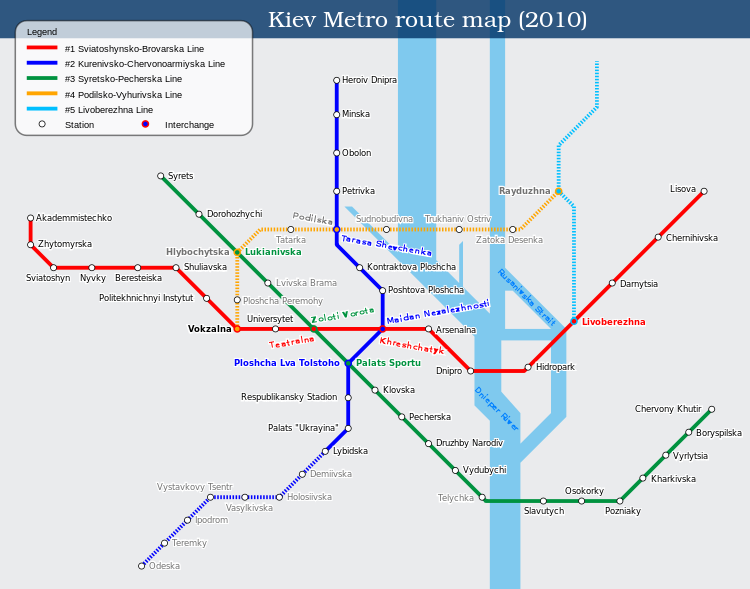
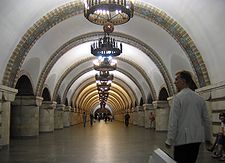
The metro follows a standard Soviet triangle three line, six radii layout that intersects in the centre where the stations are built very deep underground and could potentially double as bomb shelters.
Presently, there are 46 stations[1] of which almost half are deep level and the rest sub-surface. The former comprise 20 stations, of which 15 are of pylon type, 3 are of column type, and 2 stations are wall-columned. Of the 20bsub-surface stations, 12 stations are of pillar-trispan type, two are side-platform pillar bi-spans, 5 more are single-vaults, and a further one is an asymmetrical double deck trispan. In addition, 6 stations are located above ground, of which four are surface level, and two are flyover. Most of the stations have large vestibules, some on surface level whilst others are underground interlinked with subways. Recently, access for disabled persons, previously overlooked, has become an important issue, and all new stations have been constructed with necessary provisions.
Three yards provide a total of 664 metro cars which form 131 trains that travel on 58.8 km of track carrying 1.6 million passengers daily between 6:00 and 0:00 when the metro is open.
Ticket prices

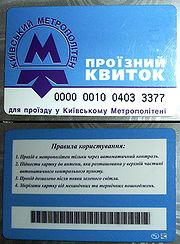
A single ride costs 1.70 hryvnia (about 0.25 USD at July 2010 exchange rate) regardless of destination and number of transits within the metro. The ride is paid by plastic tokens and contactless cards when entering the metro.
Plastic tokens are used for turnstiles; the tokens can be bought from cashiers at all stations or from automatic exchange machines that exchange 2 and 10 Hryvnia bills into tokens. The current tokens are of blue color; before 2008 green tokens were used that are no longer valid.
Contactless (RFID-based) cards are also used to enter the metro. The card can be purchased for a small fee (7 hryvnias as of 2010) and loaded for up to 50 trips with the same per-ride price as tokens. Also, the cards can be purchased for unlimited rides for a half month, one month, three months, or one year.
In late 1990s - early 2000s, monthly metro passes with a magnetic string were used. This technology had not been perfected as it required several repeat attempts for the ticket to be read.
Originally the Metro ride cost 0.5 Soviet rubles (50 kopecks), however in 1961 following Soviet denomination, and for the next 30 years, the ride was fixed at 0.05 rubles (5 kopecks). Since 1991 as the country suffered from hyperinflation the price gradually rose by 1996 to 30,000 karbovanets. Following the 1996 denomination 30,000 karbovanets became 0.3 hryvnias (30 kopiyok). Since then the price was raised twice, to 50 kopiyok in 2000 and to 2 hryvnia in 2008 (later reduced to 1.70). The price is set by the Kiev City Administration subject to approval of the national government. In November 2008 when the price was increased to 2 hryvnia, there were public protests and the Antitrust Committee of Ukraine ordered to decrease the price to 1.70 hryvnia as of January 23, 2009.
A proposal to set prices according to the distance traveled, or time spent in the metro, is currently being discussed. For this purpose, turnstiles have already been installed near metro exits.
History
The story for a rapid transit system in Kiev originates back to 1916 when businessmen of the Russo-American trading corporation attempted to collect funds to sponsor construction of a metro in Kiev, which previously has been a pioneering city for Imperial Russian rapid transit, like opening of the first Russian tram system. After the downfall of the Tsarist government Hetman Skoropadsky was also much interested in building the system, but after the downfall of the Hetmanate in the autumn of 1918 Ukraine plunged into chaos of Civil War and the project was shelved for good.
Following the Bolshevik victory in the Russian Civil War, Kiev became only a provincial city and no large scale proposals to improve the city were drawn. Two decades later all this changed when in 1934, the capital of the Ukrainian SSR was moved from Kharkiv to Kiev. In 1936 the presidium of the Kiev Municipal Soviet analysed the first report by the Moscow Institute for Transport Engineering proposing an underground system for the reconstruction of the new capital. Funds were already allocated to plan the development, but it was discontinued in 1938 when preparation for World War II became a priority.

Following the terrible destruction suffered by the city in the war, a massive reconstruction was opened for the capital of the third largest city in the USSR. This time the Metro was in the plan and construction began in August 1949. Eleven years later the first 5.2 kilometre segment from the Vokzalna to Dnipro.
Those five stations formed the central part of what is today known as the Sviatoshynsko-Brovarska Line, which runs from the west to the east of the city. The line crossed the Dnieper river in 1965 across a newly constructed Metro Bridge and went east to the large residential areas being built on the left bank of the river, with subsequent extensions in 1968 and 1971. At the same time it extended to Kiev's westernmost residential areas of Sviatoshyn and Bilychi in three stages 1963, 1971 and 2003.
Construction of the second line began in the early 1970s and the first three stations were opened in 1976. What became known as the Kurenivsko-Chervonoarmiyska Line continued expanding. In two stages (in 1980 and 1982) it reached Obolon, then the largest residential district, in northern Kiev. At the same time construction continued to the southwest with new stations added in 1981 and 1984.
Construction of the third, Syretsko-Pecherska Line began in 1981 for the first three station segment to open in 1989 in central Kiev. Following a northwest-southeast axis, in 1991 it continued up to the left bank of the Dnieper and by 1992 crossed the river and continued into the rapidly developing Poznyaky and Kharkivskyi residential districts which it reached in 1994. In mid late 1990s construction began on expansion to the older Syrets district in the northwest direction with stations opening in 1996, 2000 and 2004. In addition some of the intermediate stations were deliberately left unfinished and opened later: Pecherska (Opened in 1997) and Vyrlytsia (in 2006).
Architecture
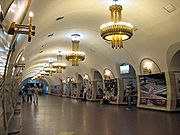
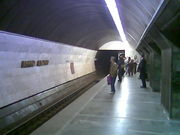

Like all Metro systems in the former Soviet Union which are known for their vivid and colourful decorations, Kiev's is no exception. The original stations of the first stage are elaborately decorated, showing the postwar Stalinist architecture blended with traditional Ukrainian motifs. However as the stations were built in a time when the richly decorated Stalinist feature was already seen as nothing but an extra, the stations of the second stage that opened in 1963 had an ascetic and strict appearance. Functionality became the most important factor in the newer designs, and stations built at that time were almost identical save the design of tile patterns and pillar riveting material. Only in the 1970s did decorative architecture start to make a rapid recovery. The stations built from the 1980s onwards show more innovative design comparing with the stations in other cities in former USSR.
Also, some of the older stations have undergone upgrades to lighting and renovation of some decorative material. After the declaration of Ukrainian independence following the breakup of the Soviet Union in 1991, some of the Soviet symbols originally incorporated into decor were adapted to modern times or removed altogether by altering architectural composition of those stations, making them lose some of their original splendour.
Language issues
The use of Russian and Ukrainian languages in the Kiev metro can be taken as a good illustration of the linguistic policies of the Soviet Union and Ukraine. When the Metro was opened in 1960, although many workers and all technical level documents were using Russian, nevertheless all the signs and announcements used Ukrainian exclusively. The closeness of the languages did allow for every station to have a Russian translation and these were often given in Russian language literature and media. However some Ukrainian names for stations were different from Russian ones, and to signify this, those stations were semi-translated into Russian, effectively blending Ukrainian words into Russian grammar. Examples of this include Zhovtneva and Chervonoarmiyska (later renamed to Beresteiska and Palats Ukrayina respectively) which when translated into Russian would become Oktyabrskaya and Krasnoarmeiskaya. The names were instead given as Zhovtnevaya and Chervonoarmeiskaya.
During the 1980s, partly due to Shcherbytsky's gradual Russification campaign, and partly due to Kiev becoming increasingly Russophone, the metro started to change as well. Although the stations retained their original Ukrainian titles on the vestibules, Russian appeared together with Ukrainian on the walls, and replaced Ukrainian in signs and voice announcements. Stations that were opened during this period still had Ukrainian names appearing along with Russian ones on the walls, but now all the decorations, where slogans were included, became bilingual as well. Also during this time, the unique practice of blending Ukrainian into Russian was dropped, and those selected stations were named in standard Russian translation.
During Perestroika in the late 1980s, bilingualism was gradually introduced in signs and in voice announcements in the trains. Prior to 1991, this was done with Ukrainian following Russian, but after the republic's proclamation of independence in August 1991 the order was changed to Ukrainian preceding Russian. After the fall of the Soviet Union in late 1991, both signs and voice announcements were changed from bilingualism to just Ukrainian due to the Ukrainianization policy. However, the Russian names are still used in Russian-language literature and some documentation, and some of the decorations still feature bilingual inscriptions.
Recently, most older signs that featured Latin transliteration of Ukrainian names along with English titles such as "transfer to" or "exit" have been replaced. Most of these were in a separate, paler font.
Operation
Management
The Kiev Metro is managed by the state-owned city municipal company Kyivsky Metropoliten which was privatised in the early 1990s from the Ministry of Rail services (formally known as Kievsky Metropoliten Ordena Lenina, Imeni V.I.Lenina). The Metro employs several thousand workers in tunnel and track, station and rolling stock management. In addition to being state sponsored for operation, income comes from ticket sales and from advertisements (controlled by a daughter company Metroreklama) that are displayed in most stations. Metro building is organised by a daughter company Kievmetrostroy which allocates segments of construction to individual brigades that are responsible for tunnel and station construction. Kievmetrostroy is directly funded by the profits of the Metro and by the state. Most of the state funding comes from Kiev's municipality and additional subventions are received from the State budget directly.
In 2009 Kiev Metro Kyivsky Metropoliten saw a loss of 210 million Hryvnya, according to them the main reason for the company's unprofitability was that the tariffs for passenger transportation did not cover costs.[3]
Quality
On the whole the condition of the metro is satisfactory for most people. For example vandalism and graffiti are not common in Kiev. Public order is now being maintained with Militsiya (police) personnel on all stations. In the wake of recent terrorist fears, all of the stations are now fitted with CCTV surveillance cameras.
The rolling stock is often repaired and renovated internally and externally. Newer models are being procured at the same time. references?
There are restrictions on the size of luggage that passengers are allowed to carry, and those that do are required to pay additional fees. Bicycles and animals are not allowed.
Until recently, amateur photography was frowned upon, and video shooting remains illegal.
Provisions for disabled people, until recently, were non-existent. However, the new stations are now fitted with lifts and plans are underway to upgrade the older stations as well.
Construction and future plans
Future plans for the Kiev Metro aim to nearly double its length by 2030-35. Presently several projects are underway:
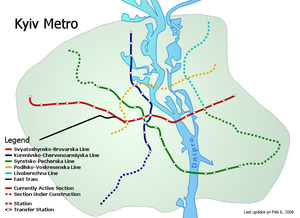
- Extension of Kurenivsko-Chervonoarmiyska Line to Teremky will extend the line to Kiev's south-western districts of Holosiiv and Teremky. It was originally planned for the 1990s, but cut in preference of the development for the Syretsko-Pecehrska Line. By the end of 2010, three new stations (Demiivska, Holosiivska, and Vasylkivska) are expected to be open.[4][5] Subsequent extension is not announced, but will include two branches with five stations in total.
- Podilsko-Vyhurivska Line. Possibly one of the most ambitious projects, but nonetheless a very important one, the fourth line of the Kiev Metro will connect the northern Troieschyna districts of the left bank with the future business centre of Trukhaniv Island on the Dnieper River, from there it will continue into the Podil region. This is the stage that is presently under construction as the river crossing is essential and will be, like in two previous cases, both automobile and Metro. However the line will continue eastwards along the northern slope of the Starokyivska Hora and into the northwestern part of central Kiev, where it will turn south and reach the Kiev Passenger Railway Station. In doing so it will offer transfers to all three other Metro lines and thus relieve the over-congested transfer points in the centre. The Podilskiy radius is the last planned stage which will bring the line to Kiev's Zhuliany airport and the residential districts on the way there. It is thought that this project the first part of it to open circa 2015 will be finished within 10 years by 2025.
- Extension of Syretsko-Pecherska Line to Darnytsia will begin from the existing station of Boryspilska and turn by nearly 90 degrees northwestwards toward the new Darnytsia Railway Station connecting the residential area in between, construction is to finish by 2020, but is suspended due to suspension of construction of Darnitskiy Vokzal.
- Extension of Syretsko-Pecherska Line to Vynohradar is a three station extension to the Vynohradar district in north western Kiev. It is approved and should be completed by 2015-20.
- Livoberezhna Line. The northern end of the fifth line of the system presently exists already as part of the Kiev tram, however it will require conversion and will be temporarly operated by the Podilsko-Vyhurivska Line as a branch. Eventually a southwards extension will commence that will follow along the left bank of the Dnieper to Southern Osokorky district, this will be the last project in the Metro that is envisioned in the present expansion plan and is not expected to be completed until the end of 2030s. It is planned that the first stage of this line will be launched in 2019.[6]
If all of this is completed the Metro will rise from the present 45 stations to approximately 100, which will include several ghost stations on the Syretsko-Pecherska Line. In the more distant future it is expected that rapid transit will be developed further including a surface ring railway which will go around Kiev and a rapid rail exchange with Boryspil Airport.
See also
- List of rapid transit systems
- Transport in Ukraine
References
- ↑ 1.0 1.1 1.2 Kyiv decides to spend Hr 20.2 million on 50 anniversary of metro, Kyiv Post (December 28, 2009)
- ↑ Официальный сайт киевского метрополитена
- ↑ Kyiv Metropolitan sees Hr 210 million loss in 2009, Kyiv Post (January 21, 2010)
- ↑ Азаров поручил достроить метро на Теремки до конца года
- ↑ Будівництво трьох станцій метрополітену у бік житлового масиву Теремки знову у центрі уваги влади
- ↑ Two companies rival to construct the first stage of Livoberezhna line of Kyiv’s metro, Kyiv Post (December 31, 2009)
- "Official site of Kiev Metro" (in Ukrainian). http://www.metro.kiev.ua.
- "Unofficial site of Kiev Metro" (in Russian). http://www.metropoliten.kiev.ua.
- Kiev "Metro" (in Russian). railroad.kiev.ua. http://railroad.kiev.ua/metro Kiev.
- "Kiev Metro". UrbanRail.net. http://urbanrail.net/eu/kie/kiev.htm.
- "Kiev Metro" (in Russian). Daniil Stolyarov site. http://xussrsubways.by.ru/kiev.htm.
- "Kiev Metro" (in Russian). Dmitry Aksyonov site. http://metroworld.ruz.net/others/kyjiv_index.htm.
- "Kiev Metro" (in Russian). meta.metro.ru. http://meta.metro.ru/kiev/kiev.html.
- "Kiev Metro" (in Russian). metrosoyuza.net. http://www.metrosoyuza.net/r/kiev/ki-uebers-h-d.html.
External links
- Kyivsky Metropoliten — Official website (Ukrainian)
- Kievsky Metropoliten — Popular site, supported by metrofan Vadim Dzygoon (Russian)
- UrbanRail — Description and images (English)
- 81-717 Kiyev: Photo gallery — Popular site, supported by metrofan Denis Andreanov (Russian)
- Metro Soyuza — Images and basic info (Russian)/(German)
- Zarohem — Extensive collection of Images, Video and Audio (Czech)
- Discovering the Kyiv Metro, "Kyiv in Your Pocket"
- Photos of Kiev Metro on virtual photo gallery (Russian)/(Ukrainian)
- FastMetro Scheme and schedule of Kyiv metro stations (Ukrainian)
|
||||||||||||||||||||||||||
|
|||||